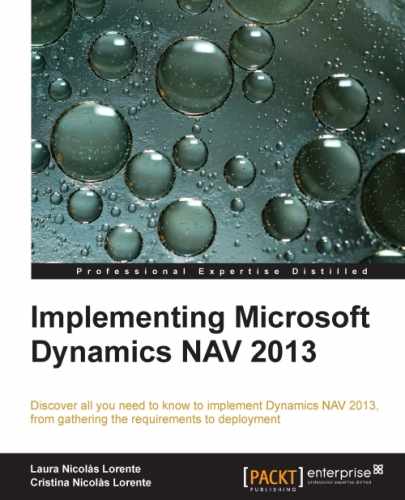For a really successful implementation of Microsoft Dynamics NAV, the company for which NAV is implemented has to actively participate on the project.
In this chapter we will cover the following aspects of the work a company should do to implement an ERP system like Microsoft Dynamics NAV:
- Define goals
- Define internal processes
- Define requirements for the new ERP system
- Involve end users
- Follow up the whole process of implementation
We will explain the theory of all these points, but we will also follow up the whole process with a very specific example from a real implementation.
Implementing Dynamics NAV as your ERP system is not a turnkey kind of project. It is not a product that you can order to a Dynamics NAV implementer, pay the bill, and just wait for the go-live day expecting everything to work perfectly. Several people within your organization have to get actively involved during all the phases. The quality of their job will affect the final result of the implementation.

In the previous diagram you can see that implementing Dynamics NAV 2013 on the partner side is a project that can be framed within a larger project—the implementation of Dynamics NAV 2013 at the customer's side. Depending on the scope of the project, the amount of work on each side may differ.
As in any project, the definition of goals is essential to measure whether the project succeeds or not. Goals have to be clearly defined at the beginning of the project and all parties must agree on them. If you don't define clear goals, you may find yourself working as hard as you possibly can, and still never satisfy your boss or end users. During the project you may face several issues that you will have to solve. Do not let your project be defined as a failure just because some issues were experienced along the way. If you reach your goals, your project succeeds. Also, do not let your project be defined as a failure because your goals are not measurable. It is usual to define goals such as "improve the sales process" but by how much does it have to be improved, how are you going to measure it, and when are you going to measure it?
There are technics that help you define good goals. Remember this mnemonic: goals have to be SMART.

Define different goals for your company and for the partner that is going to implement your Dynamics NAV. Each party will be responsible for different parts of the projects and their goals must be specific to the area they are responsible for. If the definition of the goals is clear enough, it will help everybody to focus on the tasks that will help to accomplish them. This is something that will benefit both the customer and the partner.
Let's now take a specific example from a real Microsoft Dynamics NAV implementation. The example is from a company that provides public and private health care services. This company uses a specific health care software and an accounting software. They want to replace the accounting software, which only keeps track of accounting information. Their new accounting software will be Microsoft Dynamics NAV. However Dynamics NAV is not just an accounting application, it is actually an ERP system that can do several other things.
The main goal that this company wants to accomplish with Dynamics NAV is to make their departments stick to a budget. This budget will be established at the beginning of the year for each service that the departments offer. Nowadays, they do not have a detailed budget per service and they do not keep track of costs per service.
Making the departments stick to a budget is not actually a goal. It's not something specific or time bound; it is a general vision of where to go. To accomplish that vision, several goals that point in the same direction will have to be accomplished, one at a time.
The goals to accomplish that vision could be:
- Being able to define budgets per service
- Determine the service to which every cost applies
- Being able to compare budget and real costs
- Get a report of costs for a specific service
Let's take that last goal, to get a report of costs of a specific service. It is still a goal but it is not a SMART goal. It is specific, measurable, achievable, and relevant, but there is no timing for the goal. Let's write down the goal in a different way: get a report of costs for a specific service at the end of each month. That is definitely a much a better goal.
